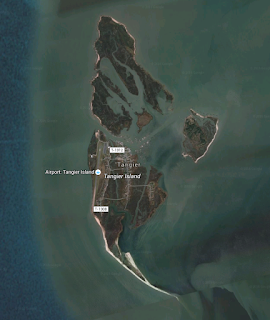Climate, environmental change hit close to home for Tangier, Indian tribes
Climate change commands global attention, but its effects are falling fast and hard on one tiny island in the Chesapeake Bay.Let me start with the usual graph of actual sea level rise in Chesapeake Bay, as measured at Baltimore, the longest record in the area:
Tangier Island has been inhabited by European settlers and their descendants since the 1600s, but a rising sea, erosion and subsidence all threaten to displace its current residents, rendering them the country's first climate refugees.
3.14 millimeters a year, plus or minus a little, with no hint of acceleration due to CO2 induced climate change in the later half of the 20th century. That's about the thickness of a nickel a year. That includes components from the increasing volume of water in the ocean from various sources (mostly ice melt) and subsidence from the effects of glacial rebound further north.
"The island is actually sinking slowly," Quinn Monette, a junior at the College of William and Mary, said Wednesday. "A study by the U.S. Army Corps of Engineers fairly recently projected the island would be completely underwater within the next 50 to 100 years if nothing is done to mitigate it."
 |
| Tangier Island, Virginia |
Salt marsh is capable of rising with sea level at moderate rates. Grass grows up catches suspended sediment, dies, and forms a layer of dead grass and sediment on the surface in fall. Slowly, these get buried and turned to peat, and the land rises to match sea level. Faster sea level rise merely encourages the grass to grow faster.
 |
| Eastern shore island showing sod or peat bank |
Calling the Tangier Islanders "the country's first climate refugees" is, of course, crap. They're being slowly ousted by the same forces that pushed countless

No comments:
Post a Comment